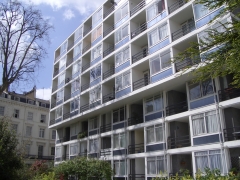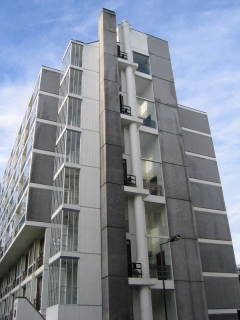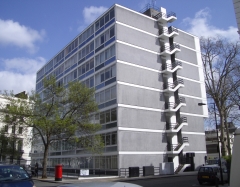The exterior of the block is elegant and simple, of a
modernist style with references to Le Corbusier. As an
application of Mies von der Rohe's idea that "less is
more", pure geometrical forms and lines are emphasized,
and the three main building materials are easily
identified as concrete, metal and glass. The horizontal
concrete floor slabs are emphasized with white paint,
and the vertical concrete elements - side walls and
divisions between apartments - are coloured grey to
indicate their different function. The use of strong
metal window frames allows for a slender frame design
and large windows, which increases the visual
transparency of the block. The mirror-backed glass
panels under the windows deliberately reflect the sky
and surrounding buildings, making the block look
relatively small and light. This was meant to achieve a
modest architecture and to respect as much as possible
the character and scale of the traditional London town
terrace opposite. Kenneth Frampton says that the mass
of the building owes to the ideas of Atelier 5 in
Switzerland, contemporaries whose work was well
respected for its logical proportions and humane
planning.
The back of the building is equally minimalist, but it
is enlivened and opened up by the subtle rhythm of inset
balconies and by the contrasting black railings.
The carefully detailed service column at the northern
side of Corringham was given a very different
architectural treatment. The powerful vertical emphasis
of the lift shaft, stair well and boiler flue gave
Corringham a reputation as one of the first major
buildings in the sculptural "brutalist" style in Central
London. Its design refers to the architecture of James
Stirling and to the practice of Lyons, Israel and Ellis,
the "birthplace of true brutalism in Britain". The
deliberately visible incorporation of the rubbish chute
and extractor fans is an application of Le Corbusier's
idea that a house is a "machine for living in". Clearly
"form follows function" here - as professed by the
American architect Louis Sullivan, sometimes called
the father of modernism. The design of a separate
service column is used in a more extreme form in
Ernö Goldfinger's Balfron Tower nearby.
The service column reveals some of the internal
complexity of the building through its floor-to-ceiling
windows. There is only one landing for every two floors
- as Corringham is one of the few buildings in the
world constructed with the elegant split-level
"scissor design".
Scissor design
The architect of the building, Kenneth Frampton of
Douglas Stephen & Partners, was confronted with high
land costs and strict planning restrictions. The height
and depth of the block had to match the outline of the
Edwardian buildings that once stood on the same site.
To observe these restrictions and still fit 48
apartments in the block Kenneth Frampton used the then
practically new scissor design in which each up-going
flat interlocks with its down-going neighbour. This
design reduces the number of corridors required - there
are only five to service all eight floors - and allows
for a more compact construction without compromising
the size of the apartments.
An added advantage of this scissor design is that all
living rooms are at the western side of the block,
receiving direct sunlight in the afternoon. The bedrooms
are all at the opposite, quieter side, overlooking the
communal garden to the east, so that residents wake up
with sunlight on their pillows. This layout of the
block maximises the light and natural ventilation
in each flat, while the noise cross-over from living
rooms to bedrooms is minimized. The split-level layout
of the apartments increases the feeling of spaciousness.




